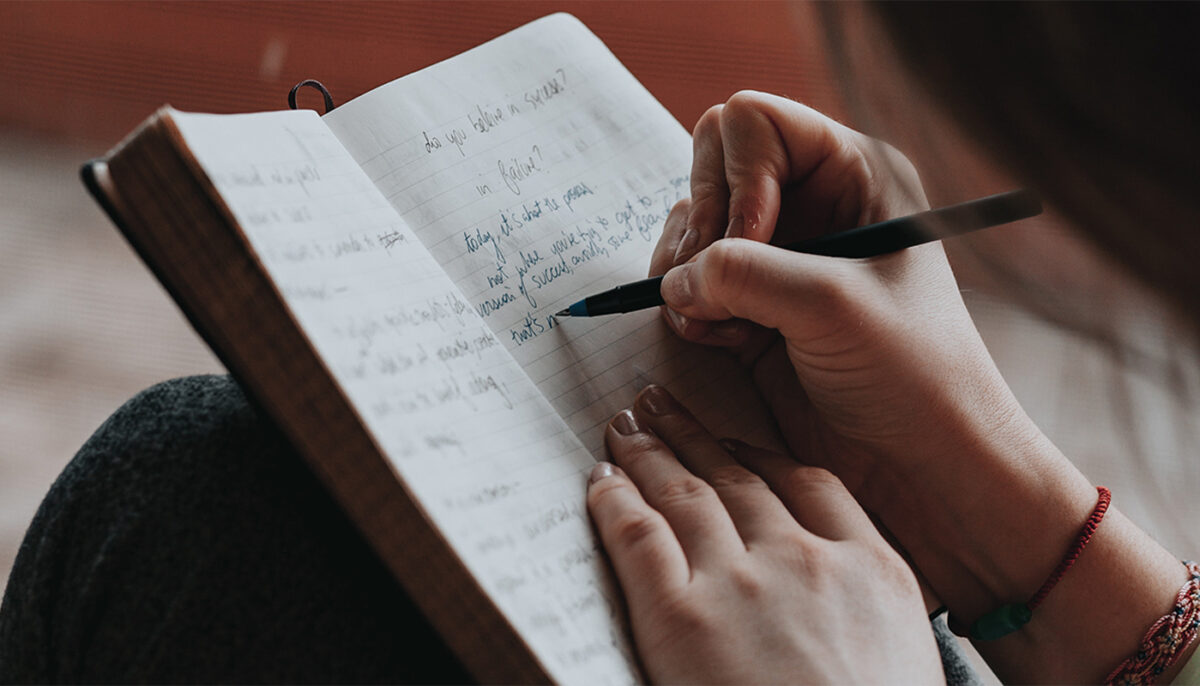
So you want to learn how to write lyrics? Whether you’re looking to pen the next big hit or you’re just hoping to tell your own story in an authentic way, writing lyrics can be a fun and highly cathartic creative process. Lyric writing can also be a scary task to take on if you’ve never written a song before!
As a professional songwriter of 12 years, I still have days where my mind is just as blank as the page in front of me. In all my years of songwriting, I’ve learned some useful songwriting tips that I can’t wait to share with you!
In this article, we’re going to go over five steps to help you write your first song along with some of my own lyric writing tips that have helped me to write lyrics that truly resonate with listeners over the years.
Learn how to write song lyrics:
How to write song lyrics
1. Choose your story
Lyric writing, at its core, is about storytelling. So it makes sense to know what story you want to tell before you begin! Start by choosing a topic or theme you want to write about. It could be a personal experience, a feeling, or a message you want to pass on to the listener.
If you’re trying to write your first song, my advice is to tell a story that you’ve actually lived through. This will help to give your lyrics a sense of authenticity. There’s a reason people say “write what you know.” Most listeners can tell when song lyrics are authentic and honest (or not).
For example: unless you’ve actually partied in Ibiza, it’s probably best not to write about it. But, for Mike Posner, the opening line of “I Took A Pill In Ibiza” really comes off quite honest and vulnerable.
The best lyrics tend to be more “emotionally charged.” This helps the listener to feel what the writer was feeling. So if you want your lyrics to really connect with others, it helps to choose a story you truly care about.
When learning how to write good lyrics, try to use imagery and metaphors to create a more vivid and engaging story. This can help your audience connect with the emotions and experiences you’re describing. Try to focus on activating multiple senses (sight, sound, taste, touch, and smell) in order to bring the listener into your world.
For example, rather than saying “the tea tasted like lavender,” you could say “the lavender lounged on my tea-soaked tongue.” Although both are relaying the same facts of the story, the second version allows the listener to activate more of their senses.
2. Brainstorm ideas
Once you have the story you wish to tell, start brainstorming some ideas around it. Write down any words, phrases, or images that come to mind. Don’t worry about making them rhyme or fit into any specific structure at this point. The key here is to just get your ideas out onto the page so you actually have some pieces to work with.
When you’re brainstorming ideas, make sure to focus on the audience. Ask yourself “who is this song for”? Is it for you? Your friends? A room of metalheads moshing their brains out?
Obviously, you’ll want to use words, phrases, and lyrical styles that are fitting for your audience. But, even the lyric “put your hands up” carries a totally different meaning when you’re talking to one person, versus a thousand. Keeping your audience in mind will allow you to better speak directly to them.
Brainstorming can also happen at any time in the songwriting process. Inspiration doesn’t always just flow the second you sit down to write a song! It helps to have a way to store your creative ideas when you’re on the go. Whether you bring along a physical journal, or simply record voice memos in an app on your phone, having a way to jot down your ideas on the fly will provide you with a useful collection to look back on when it is time to sit down to write.

You don’t just have to take notes from your own experiences either. Pay close attention to the lyrics in songs you like. What makes their lyrics do it for you? Do they use a unique rhyme scheme or is it their poetic imagery that you like? Perhaps it’s the subject matter of the song that really helps it hit home for you. Whatever the case may be, start listening to lyrics analytically and try to figure out how to implement what you enjoy into your own writing style.
Some of my favorite songwriters I draw inspiration from are K.Flay, Julia Michaels, Dean Lewis, and SYML.
When in brainstorming mode, it also helps to have some music software tools at the ready. If you’re just getting into the world of songwriting, I would recommend checking out KOMPLETE START. This free bundle of synths, sampled instruments, loops, and other sounds is sure to spark some inspiration.
3. Structure your song
Now that you have a bundle of decent ideas to work with, it’s time to start polishing and piecing them together into a completed song with proper song structure. Keep in mind that structuring a song is always a subjective process and there are different ways to approach it depending on the genre and your own personal preferences.
Most songs typically include these sections:
- Intro: The beginning of the song, usually instrumental or with minimal vocals, to grab the listener’s attention.
- Verse: The section that sets up the story or message of the song, usually with a consistent melody and chord progression.
- Chorus: The section with a catchy melody and lyrics that the listener can sing along with. The chorus usually contains the main message or “hook” of the song.
- Bridge: A section that provides contrast to the verse and chorus, both musically and lyrically. It often serves as a transition between the two and adds more depth and dynamic to the song.
- Outro: The end of the song, which can either be a repetition of the chorus or a unique ending.
Many song writers typically save their best lyrics for the chorus. After all, you do want the chorus to be the catchiest bit. But it’s often a good rule of thumb to start your song off with something that’ll “hook” the listener.
The opening sentence of a book is arguably the most important, because that line determines if the reader will keep on going. Since the main goal of writing good song lyrics is to get the listener to keep listening, you’ll want to start with a strong, opening line. Grabbing the listener’s attention right off the bat will mean you’ll have a better chance of keeping them around to hear the rest of your story.
And when piecing your various lyrical ideas together, feel free to re-order the typical song sections above to your liking. The main goal of this process is to experiment and find a structure that works best for allowing your lyrics to flow smoothly. Think back to the story you’re trying to tell. What sort of structure would help you tell that story best?
4. Put your lyrics to music
Once you have the structure of your song pretty well figured out, it’s time to put your lyrics to music.
Choose a chord progression for each section of your song. Keep in mind that it’s pretty common to use the same chord progression for the verses and chorus, but typically the bridge section switches things up at least a little bit in order to build tension between the verse and chorus.
Unless you’re writing rap lyrics, it’s important that your lyrics also follow a strong melody. But again, the point is to play with it and see which melody fits with your chord progression AND your lyrics.
We’ve been talking about chord progressions, melodies, and song structure—all key components of songwriting. Understanding music theory as well as these concepts obviously helps when it comes to crafting chord progressions and melodies for your lyrics to pair with. If you’re brand new to the world of songwriting, take a look at this introduction to music composition.
5. Refine and edit your lyrics
Once you have a draft of your song lyrics, take the time to refine and edit them. Look for ways to improve the flow, rhythm, and structure of your song. Try to eliminate any unnecessary words or phrases, unless they contribute to the overall cadence you’re needing in order to tell your story best.
Arrange, rearrange, and fine-tune your lyrics to make sure they’re easily singable. It always helps me to practice singing or reciting the lyrics out loud because this lets me identify any awkward phrases or sections that need revision. Keep reworking it until you’re happy with the final result!
And it’s important to remember this when learning how to write good lyrics: If your lyric writing is lacking inspiration, don’t be afraid to take a break, go out into the world, and have some experiences worth writing about!
I’ll often go in phases of songwriting. Sometimes I’ll write three songs in a day. And other times I won’t write anything for three months. It all just depends on the state of my life at the time. I’ve found that if you’re itching to write some new lyrics and nothing is flowing, there’s no shame in taking yourself on an adventure to go find some fresh inspiration.

Start writing song lyrics
Remember, songwriting is a process that takes time and practice. I’ve been writing songs for nearly 25 years, but I feel I’ve only been writing good songs for the last decade.
It’s a technical art that needs to be honed, crafted, molded, and nurtured; but, the goal of writing great lyrics should always be to share your own story. So, don’t be afraid to experiment and try new things—that’s how you’re going to bring your own, unique voice into the world!
For further reading on the subject, check out this guide on songwriting basics. And if you haven’t already, get KOMPLETE START for free to get access to tons of sounds, instruments, and more to inspire your songwriting.















